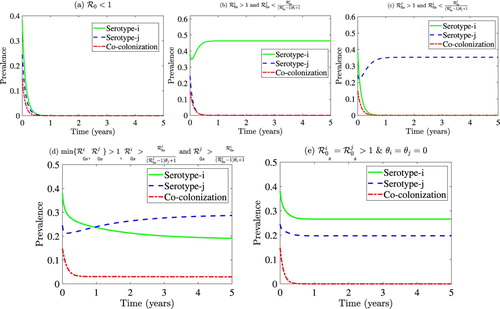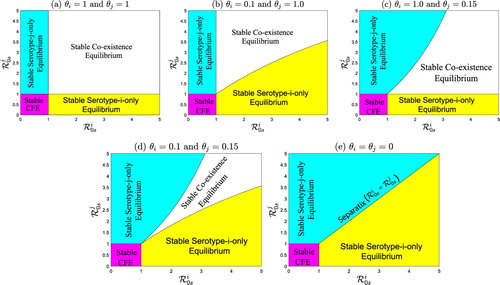Figures & data
Figure 1. Flow diagram of the model (EquationA.1(A.1)
(A.1) ), showing the transitions of the unvaccinated (left) and vaccinated (right) state variables (or components) of the model.
![Figure 1. Flow diagram of the model (EquationA.1(A.1) (Nu)′=Λ(1−ϕ)+ωNv−(λi+λj+μ)Nu,(Nv)′=Λϕ−[(1−ϵ)λi+λj+ω+μ]Nv,(Cui)′=λiNu+ηiλiRuni−(γi+θiλj+μ)Cui,(Cvi)′=(1−ϵ)λiNv+ηiλiRvni−(θvγi+θiλj+μ)Cvi,(Cuj)′=λjNu+ηjλjRunj+ωCvj−(γj+θjλi+μ)Cuj,(Cvj)′=λjNv+ηjλjRvnj−[γj+θj(1−ϵ)λi+ω+μ]Cvj,(Cuij)′=θiλjCui+θjλiCuj+θjηiλiCunij+θiηjλjCunji−(γij+μ)Cuij,(Cvij)′=θj(1−ϵ)λiCvj+θiλjCvi+θjηiλiCvnij+θiηjλjCvnji−[(θv(1−r2)+r2)γij+μ]Cvij,(Runi)′=γiCui−(ηiλi+λj+μ)Runi,(Rvni)′=θvγiCvi−(ηiλi+λj+μ)Rvni,(Runj)′=γjCuj+ωRvnj−(ηjλj+λi+μ)Runj,(Rvnj)′=γjCvj−[ηjλj+(1−ϵ)λi+ω+μ]Rvnj,(Runinj)′=γiCunji+γjCunij+(1−r1−r2)γijCuij−(ηiλi+ηjλj+μ)Runinj,(Rvninj)′=θvγiCvnji+γjCvnij+θv(1−r2)(1−r1)γijCvij−(ηiλi+ηjλj+μ)Rvninj,(Cunji)′=λiRunj+ηiλiRuninj+r2γijCuij−(γi+θiηjλj+μ)Cunji,(Cvnji)′=(1−ϵ)λiRvnj+ηiλiRvninj+r2γijCvij−(θvγi+θiηjλj+μ)Cvnji,(Cunij)′=λjRuni+ηjλjRuninj+r1γijCuij−(γj+θjηiλi+μ)Cunij,(Cvnij)′=λjRvni+ηjλjRvninj+θv(1−r2)r1γijCvij−(γj+θjηiλi+μ)Cvnij.(A.1) ), showing the transitions of the unvaccinated (left) and vaccinated (right) state variables (or components) of the model.](/cms/asset/bf27669d-d42d-4ff6-b54d-d11cb3235157/tjbd_a_1884760_f0001_oc.jpg)
Table 1. Description of the state variables of the model (EquationA.1(A.1)
(A.1) ).
.
Table 2. Description of parameters of the model (EquationA.1(A.1)
(A.1) ).
Figure 2. Simulation of the simplified model, showing convergence of the initial solutions (given by ) to carriage-free equilibrium. Parameter values used are:
,
, c = 4508,
,
,
,
,
and (a)
,
(so that,
,
and
), (b)
,
(so that,
,
and
), (c)
,
(so that
,
and
), (d)
,
(so that,
,
,
and
) and (e)
,
(so that,
). All the rate parameters are in years.

Figure 3. Illustration of the results in Theorems 3.4, 3.5 and Conjecture 3.1, showing stability regions of the equilibria of the simplified model in the parameter space for various values of the serotype-specific competition parameters,
and
. The values of
and
used to compute the thresholds given in Theorems 3.4, 3.5 and Conjecture 3.1 are: (a)
, (b)
and
, (c)
and
, (d)
and
, and (e)
. In this case, a boundary equilibrium containing serotype-i and serotype-j (without co-colonization) exists and is stable. The rate parameters are in years.

Figure 4. Effect of cohort vaccination coverage (ϕ) on the prevalence of the two SP serotyes and co-colonization. Simulations of the vaccination model (EquationA.1(A.1)
(A.1) ), showing the prevalence of VT, NVT and co-colonization and overall community-wide vaccination coverage, as a function of time for (a) no cohort vaccination(
), (b) low coverage level of cohort vaccination (
) and (c) high coverage level of cohort vaccination (
). Other parameter values used are as given in Table . The constituent reproduction numbers of the vaccination model for each of the settings (a)–(d) above are given by (a)
,
(so that,
), (b)
,
(so that,
), and (c)
,
(so that,
). The rate parameters are in years.
![Figure 4. Effect of cohort vaccination coverage (ϕ) on the prevalence of the two SP serotyes and co-colonization. Simulations of the vaccination model (EquationA.1(A.1) (Nu)′=Λ(1−ϕ)+ωNv−(λi+λj+μ)Nu,(Nv)′=Λϕ−[(1−ϵ)λi+λj+ω+μ]Nv,(Cui)′=λiNu+ηiλiRuni−(γi+θiλj+μ)Cui,(Cvi)′=(1−ϵ)λiNv+ηiλiRvni−(θvγi+θiλj+μ)Cvi,(Cuj)′=λjNu+ηjλjRunj+ωCvj−(γj+θjλi+μ)Cuj,(Cvj)′=λjNv+ηjλjRvnj−[γj+θj(1−ϵ)λi+ω+μ]Cvj,(Cuij)′=θiλjCui+θjλiCuj+θjηiλiCunij+θiηjλjCunji−(γij+μ)Cuij,(Cvij)′=θj(1−ϵ)λiCvj+θiλjCvi+θjηiλiCvnij+θiηjλjCvnji−[(θv(1−r2)+r2)γij+μ]Cvij,(Runi)′=γiCui−(ηiλi+λj+μ)Runi,(Rvni)′=θvγiCvi−(ηiλi+λj+μ)Rvni,(Runj)′=γjCuj+ωRvnj−(ηjλj+λi+μ)Runj,(Rvnj)′=γjCvj−[ηjλj+(1−ϵ)λi+ω+μ]Rvnj,(Runinj)′=γiCunji+γjCunij+(1−r1−r2)γijCuij−(ηiλi+ηjλj+μ)Runinj,(Rvninj)′=θvγiCvnji+γjCvnij+θv(1−r2)(1−r1)γijCvij−(ηiλi+ηjλj+μ)Rvninj,(Cunji)′=λiRunj+ηiλiRuninj+r2γijCuij−(γi+θiηjλj+μ)Cunji,(Cvnji)′=(1−ϵ)λiRvnj+ηiλiRvninj+r2γijCvij−(θvγi+θiηjλj+μ)Cvnji,(Cunij)′=λjRuni+ηjλjRuninj+r1γijCuij−(γj+θjηiλi+μ)Cunij,(Cvnij)′=λjRvni+ηjλjRvninj+θv(1−r2)r1γijCvij−(γj+θjηiλi+μ)Cvnij.(A.1) ), showing the prevalence of VT, NVT and co-colonization and overall community-wide vaccination coverage, as a function of time for (a) no cohort vaccination(ϕ=0), (b) low coverage level of cohort vaccination (ϕ=0.4) and (c) high coverage level of cohort vaccination (ϕ=0.8). Other parameter values used are as given in Table 2. The constituent reproduction numbers of the vaccination model for each of the settings (a)–(d) above are given by (a) Rvi=1.865, Rvj=1.72 (so that, Rv=1.865), (b) Rvi=1.799, Rvj=1.72 (so that, Rv=1.799), and (c) Rvi=1.73, Rvj=1.72 (so that, Rv=1.73). The rate parameters are in years.](/cms/asset/c8fe12c6-479c-4453-90ff-bc7566fc8341/tjbd_a_1884760_f0004_oc.jpg)
Figure 5. Effect of serotype-specific competition parameters, and
, and cohort vaccination (ϕ) on the prevalence of VT, NVT and co-colonization. Simulations of the vaccination model (EquationA.1
(A.1)
(A.1) ), showing the prevalence of VT, NVT and co-colonization as a function of time for (i) low serotype-specific competition:
and (a) no cohort vaccination (
), (b) low coverage level of cohort vaccination (
), and (c) high coverage level of cohort vaccination (
), (ii) moderate serotype-specific competition:
and (d) no cohort vaccination (
), (e) low coverage level of cohort vaccination (
), and (f) high coverage level of cohort vaccination (
), and (iii) low serotype-specific competition
and (g) no cohort vaccination (
), (h) low coverage level of cohort vaccination (
), (i) high coverage level of cohort vaccination (
). Other parameter values used are as given in Table . The reproduction numbers for these simulations are given as follows: (i) no cohort vaccination (
):
,
(so that,
); (ii) low coverage level of cohort vaccination (
):
,
(so that,
); (iii) high coverage level of cohort vaccination (
):
,
(so that,
). The rate parameters are in years.
![Figure 5. Effect of serotype-specific competition parameters, θi and θj, and cohort vaccination (ϕ) on the prevalence of VT, NVT and co-colonization. Simulations of the vaccination model (EquationA.1(A.1) (Nu)′=Λ(1−ϕ)+ωNv−(λi+λj+μ)Nu,(Nv)′=Λϕ−[(1−ϵ)λi+λj+ω+μ]Nv,(Cui)′=λiNu+ηiλiRuni−(γi+θiλj+μ)Cui,(Cvi)′=(1−ϵ)λiNv+ηiλiRvni−(θvγi+θiλj+μ)Cvi,(Cuj)′=λjNu+ηjλjRunj+ωCvj−(γj+θjλi+μ)Cuj,(Cvj)′=λjNv+ηjλjRvnj−[γj+θj(1−ϵ)λi+ω+μ]Cvj,(Cuij)′=θiλjCui+θjλiCuj+θjηiλiCunij+θiηjλjCunji−(γij+μ)Cuij,(Cvij)′=θj(1−ϵ)λiCvj+θiλjCvi+θjηiλiCvnij+θiηjλjCvnji−[(θv(1−r2)+r2)γij+μ]Cvij,(Runi)′=γiCui−(ηiλi+λj+μ)Runi,(Rvni)′=θvγiCvi−(ηiλi+λj+μ)Rvni,(Runj)′=γjCuj+ωRvnj−(ηjλj+λi+μ)Runj,(Rvnj)′=γjCvj−[ηjλj+(1−ϵ)λi+ω+μ]Rvnj,(Runinj)′=γiCunji+γjCunij+(1−r1−r2)γijCuij−(ηiλi+ηjλj+μ)Runinj,(Rvninj)′=θvγiCvnji+γjCvnij+θv(1−r2)(1−r1)γijCvij−(ηiλi+ηjλj+μ)Rvninj,(Cunji)′=λiRunj+ηiλiRuninj+r2γijCuij−(γi+θiηjλj+μ)Cunji,(Cvnji)′=(1−ϵ)λiRvnj+ηiλiRvninj+r2γijCvij−(θvγi+θiηjλj+μ)Cvnji,(Cunij)′=λjRuni+ηjλjRuninj+r1γijCuij−(γj+θjηiλi+μ)Cunij,(Cvnij)′=λjRvni+ηjλjRvninj+θv(1−r2)r1γijCvij−(γj+θjηiλi+μ)Cvnij.(A.1) ), showing the prevalence of VT, NVT and co-colonization as a function of time for (i) low serotype-specific competition: θi=θj=0.8 and (a) no cohort vaccination (ϕ=0), (b) low coverage level of cohort vaccination (ϕ=0.4), and (c) high coverage level of cohort vaccination (ϕ=0.8), (ii) moderate serotype-specific competition: θi=θj=0.5 and (d) no cohort vaccination (ϕ=0), (e) low coverage level of cohort vaccination (ϕ=0.4), and (f) high coverage level of cohort vaccination (ϕ=0.8), and (iii) low serotype-specific competition θi=θj=0.2 and (g) no cohort vaccination (ϕ=0), (h) low coverage level of cohort vaccination (ϕ=0.4), (i) high coverage level of cohort vaccination (ϕ=0.8). Other parameter values used are as given in Table 2. The reproduction numbers for these simulations are given as follows: (i) no cohort vaccination (ϕ=0): Rvi=1.865, Rvj=1.72 (so that, Rv=1.865); (ii) low coverage level of cohort vaccination (ϕ=0.4): Rvi=1.799, Rvj=1.72 (so that, Rv=1.799); (iii) high coverage level of cohort vaccination (ϕ=0.8): Rvi=1.73, Rvj=1.72 (so that, Rv=1.73). The rate parameters are in years.](/cms/asset/e985c952-b2e7-42aa-9601-04927b576f83/tjbd_a_1884760_f0005_oc.jpg)
Figure A1. Data fitting of the model (EquationA.1(A.1)
(A.1) ) using the prevalence data for serotypes 19A (VT) and 35B (NVT) generated from a cohort of 6–59 months children in Atlanta, GA, in 6 study periods, 6 months apart, from July 2010 to June 2013 (the end of the first study period is considered as the initial time for the start of the simulations), as reported in [Citation16].
![Figure A1. Data fitting of the model (EquationA.1(A.1) (Nu)′=Λ(1−ϕ)+ωNv−(λi+λj+μ)Nu,(Nv)′=Λϕ−[(1−ϵ)λi+λj+ω+μ]Nv,(Cui)′=λiNu+ηiλiRuni−(γi+θiλj+μ)Cui,(Cvi)′=(1−ϵ)λiNv+ηiλiRvni−(θvγi+θiλj+μ)Cvi,(Cuj)′=λjNu+ηjλjRunj+ωCvj−(γj+θjλi+μ)Cuj,(Cvj)′=λjNv+ηjλjRvnj−[γj+θj(1−ϵ)λi+ω+μ]Cvj,(Cuij)′=θiλjCui+θjλiCuj+θjηiλiCunij+θiηjλjCunji−(γij+μ)Cuij,(Cvij)′=θj(1−ϵ)λiCvj+θiλjCvi+θjηiλiCvnij+θiηjλjCvnji−[(θv(1−r2)+r2)γij+μ]Cvij,(Runi)′=γiCui−(ηiλi+λj+μ)Runi,(Rvni)′=θvγiCvi−(ηiλi+λj+μ)Rvni,(Runj)′=γjCuj+ωRvnj−(ηjλj+λi+μ)Runj,(Rvnj)′=γjCvj−[ηjλj+(1−ϵ)λi+ω+μ]Rvnj,(Runinj)′=γiCunji+γjCunij+(1−r1−r2)γijCuij−(ηiλi+ηjλj+μ)Runinj,(Rvninj)′=θvγiCvnji+γjCvnij+θv(1−r2)(1−r1)γijCvij−(ηiλi+ηjλj+μ)Rvninj,(Cunji)′=λiRunj+ηiλiRuninj+r2γijCuij−(γi+θiηjλj+μ)Cunji,(Cvnji)′=(1−ϵ)λiRvnj+ηiλiRvninj+r2γijCvij−(θvγi+θiηjλj+μ)Cvnji,(Cunij)′=λjRuni+ηjλjRuninj+r1γijCuij−(γj+θjηiλi+μ)Cunij,(Cvnij)′=λjRvni+ηjλjRvninj+θv(1−r2)r1γijCvij−(γj+θjηiλi+μ)Cvnij.(A.1) ) using the prevalence data for serotypes 19A (VT) and 35B (NVT) generated from a cohort of 6–59 months children in Atlanta, GA, in 6 study periods, 6 months apart, from July 2010 to June 2013 (the end of the first study period is considered as the initial time for the start of the simulations), as reported in [Citation16].](/cms/asset/0b869ea2-45d4-4860-8d1d-0be6d43c7206/tjbd_a_1884760_f0006_oc.jpg)
Figure A2. Effect of cohort vaccination coverage (ϕ) on the prevalence of the two SP serotyes and co-colonization. Simulations of the vaccination model (EquationA.1(A.1)
(A.1) ), showing the prevalence of 19A, 35B and co-colonization and overall cohort-wide vaccination coverage, as a function of time for (a) no cohort vaccination(
), (b) low coverage level of cohort vaccination (
), (c) high coverage level of cohort vaccination (
). Other parameter values used are as given in Table . The initial condition for no (
), low (
) and high (
) coverage level of cohort vaccination are listed in items (i), (ii) and (iii), respectively, in Section D. The constituent reproduction numbers of the vaccination model for each of the settings (a)–(c) above are given by (a)
,
(so that,
), (b)
,
(so that,
) and (c)
,
(so that,
). The rate parameters are in years.
![Figure A2. Effect of cohort vaccination coverage (ϕ) on the prevalence of the two SP serotyes and co-colonization. Simulations of the vaccination model (EquationA.1(A.1) (Nu)′=Λ(1−ϕ)+ωNv−(λi+λj+μ)Nu,(Nv)′=Λϕ−[(1−ϵ)λi+λj+ω+μ]Nv,(Cui)′=λiNu+ηiλiRuni−(γi+θiλj+μ)Cui,(Cvi)′=(1−ϵ)λiNv+ηiλiRvni−(θvγi+θiλj+μ)Cvi,(Cuj)′=λjNu+ηjλjRunj+ωCvj−(γj+θjλi+μ)Cuj,(Cvj)′=λjNv+ηjλjRvnj−[γj+θj(1−ϵ)λi+ω+μ]Cvj,(Cuij)′=θiλjCui+θjλiCuj+θjηiλiCunij+θiηjλjCunji−(γij+μ)Cuij,(Cvij)′=θj(1−ϵ)λiCvj+θiλjCvi+θjηiλiCvnij+θiηjλjCvnji−[(θv(1−r2)+r2)γij+μ]Cvij,(Runi)′=γiCui−(ηiλi+λj+μ)Runi,(Rvni)′=θvγiCvi−(ηiλi+λj+μ)Rvni,(Runj)′=γjCuj+ωRvnj−(ηjλj+λi+μ)Runj,(Rvnj)′=γjCvj−[ηjλj+(1−ϵ)λi+ω+μ]Rvnj,(Runinj)′=γiCunji+γjCunij+(1−r1−r2)γijCuij−(ηiλi+ηjλj+μ)Runinj,(Rvninj)′=θvγiCvnji+γjCvnij+θv(1−r2)(1−r1)γijCvij−(ηiλi+ηjλj+μ)Rvninj,(Cunji)′=λiRunj+ηiλiRuninj+r2γijCuij−(γi+θiηjλj+μ)Cunji,(Cvnji)′=(1−ϵ)λiRvnj+ηiλiRvninj+r2γijCvij−(θvγi+θiηjλj+μ)Cvnji,(Cunij)′=λjRuni+ηjλjRuninj+r1γijCuij−(γj+θjηiλi+μ)Cunij,(Cvnij)′=λjRvni+ηjλjRvninj+θv(1−r2)r1γijCvij−(γj+θjηiλi+μ)Cvnij.(A.1) ), showing the prevalence of 19A, 35B and co-colonization and overall cohort-wide vaccination coverage, as a function of time for (a) no cohort vaccination(ϕ=0), (b) low coverage level of cohort vaccination (ϕ=0.4), (c) high coverage level of cohort vaccination (ϕ=0.8). Other parameter values used are as given in Table 2. The initial condition for no (ϕ=0), low (ϕ=0.4) and high (ϕ=0.8) coverage level of cohort vaccination are listed in items (i), (ii) and (iii), respectively, in Section D. The constituent reproduction numbers of the vaccination model for each of the settings (a)–(c) above are given by (a) Rvi=3.214, Rvj=1.1 (so that, Rv=3.214), (b) Rvi=2.222, Rvj=1.1 (so that, Rv=2.222) and (c) Rvi=1.23, Rvj=1.1 (so that, Rv=1.23). The rate parameters are in years.](/cms/asset/5ea5ad36-d416-4a52-a55c-550ad3c78d8a/tjbd_a_1884760_f0007_oc.jpg)
